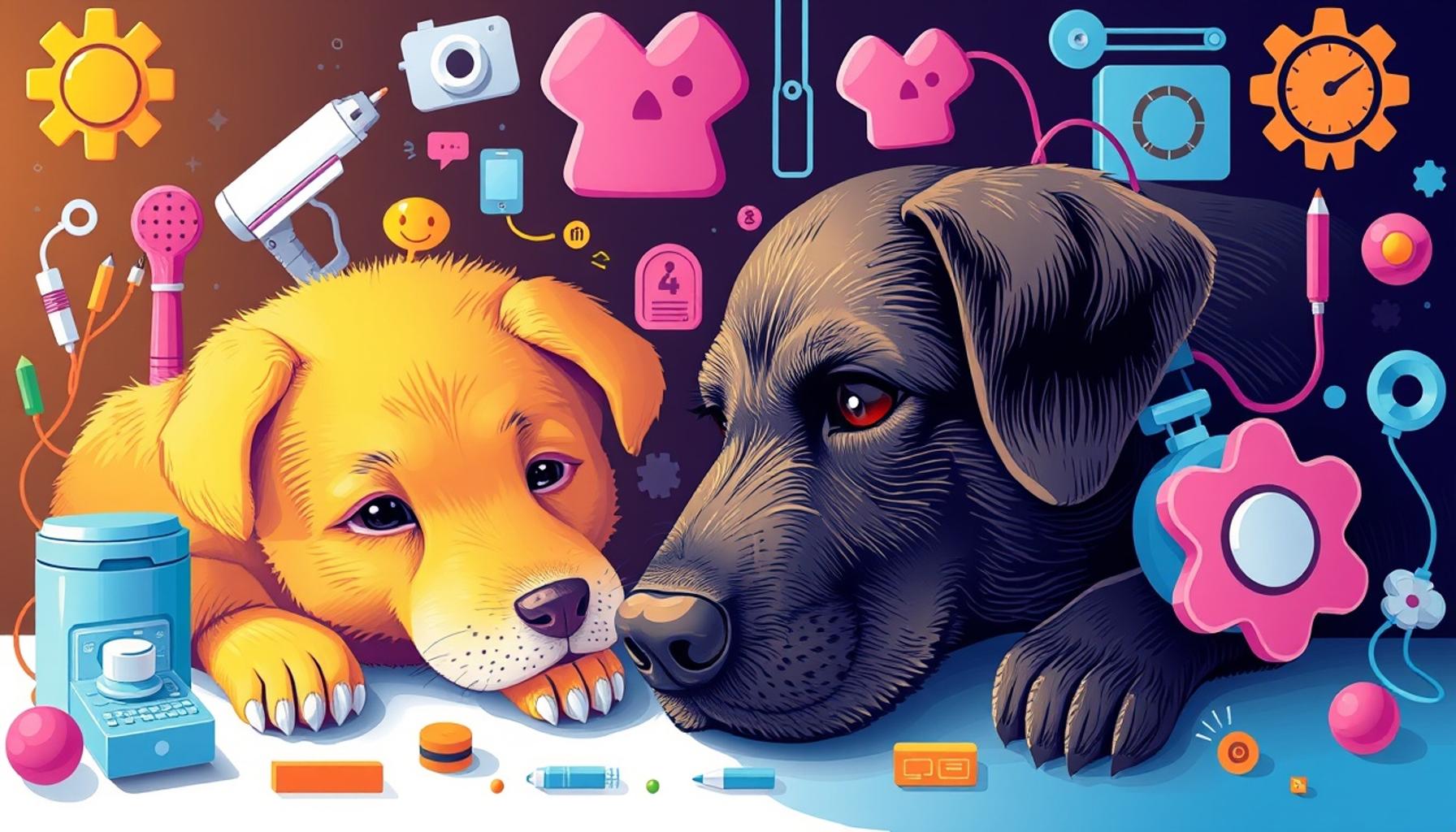The Role of Technology in the Modernization of Animal Adoption Services

The Impact of Technology on Animal Adoption Services
In a digital era where technology influences nearly every aspect of our lives, it has also begun to transform the landscape of animal adoption services. This shift is not merely about convenience; it represents a significant evolution in how shelters operate and how pets find their forever homes. Through various technologies, both animals and potential adopters benefit from an enriched experience that fosters stronger bonds.
- Increased Accessibility: One of the hallmarks of technology’s influence is the rise of robust online platforms. Websites like Petfinder and Adopt a Pet allow prospective adopters to peruse a wide range of adoptable animals from the comfort of their homes. This instant access helps people consider adoption who might not have previously thought to visit a shelter in person. For instance, families can now search for pets that fit their lifestyle needs, filtering by factors like breed, size, and age.
- Adoption Apps: Various specialized applications, such as BarkBuddy and Meet My Dog, connect shelters with potential pet parents. These apps streamline the adoption process and offer user-friendly interfaces that guide users through applications and approval processes. Features such as push notifications for new arrivals or updates on pets they’ve shown interest in keep potential adopters engaged and informed.
- Data-Driven Decisions: If shelters effectively utilize analytics, they can gain insight into adoption trends, which is crucial for improving their outreach efforts. For example, shelters can analyze which breeds are more likely to be adopted in specific regions or during particular seasons, allowing them to tailor their marketing strategies. This data not only increases efficiency but also ensures a better match between animals and owners.
These advancements have contributed to significantly higher adoption rates and more successful placements overall. The introduction of features like virtual meet-and-greets allows potential families to engage with pets before making crucial decisions. Additionally, real-time updates on pet profiles, including health status and personality traits, are now commonplace, contributing to informed choices by adopters.
Moreover, technology empowers organizations to expand their outreach through engaging social media campaigns, where compelling posts can go viral and draw attention to animals in need of homes. A striking image or a heartwarming story can make a significant difference, sparking interest that may lead to a successful adoption. Additionally, online fundraising platforms, such as GoFundMe or Kickstarter, have simplified the donation process, enabling shelters to acquire necessary funds for operations and care more effectively.
- Virtual Tours: The ability for prospective adopters to take virtual tours of shelters is another remarkable transformation. This innovative approach can help dismantle preconceived notions people may have about shelters, showcasing the loving environments where animals are cared for.
As we continue exploring the integration of technology in animal adoption services, it is essential to consider its multifaceted role in reshaping the dynamics within shelters and among adopters across the United States. This dynamic landscape is opening doors to unprecedented opportunities, ensuring that animals find loving homes in a more efficient and meaningful way. With continued innovation, the future of animal adoption looks brighter than ever.
DISCOVER MORE: Click here to learn about the impact of pet food choices

Enhancing Visibility and Matching through Technology
In recent years, the role of technology in the modernization of animal adoption services has proved to be transformative, particularly in how potential adopters discover and connect with animals in need of homes. Traditional adoption methods often posed barriers for both shelters and adopters, but the infusion of digital tools has led to a more streamlined, inclusive process.
Online Listings and Social Media: One significant advancement is the utilization of online animal listing platforms and the power of social media. Shelters have adapted their marketing strategies to include engaging content across platforms such as Instagram, Facebook, and TikTok. By sharing heartwarming photos and stories about adoptable pets, organizations have expanded their reach dramatically. In fact, studies show that social media posts related to pet adoption can reach thousands of potential adopters within hours, a feat that traditional flyers or newsletters could not achieve.
- Collaborative Networks: Many animal adoption services are now part of networks that share listings across multiple platforms. This collaboration increases the visibility of animals and promotes responsible adoption. By featuring various shelters and rescue organizations in a single database, prospective pet owners can access a wider range of options, ultimately leading to quicker adoptions.
- Engagement through Storytelling: The emphasis on storytelling has also been enhanced through technological means. Organizations often craft compelling narratives around each animal, enabling adopters to feel a stronger emotional connection. Simple updates about an animal’s journey from rescue to adoption make their stories relatable and inspire more compassionate decisions.
- Virtual Events: Many shelters have begun adopting the strategy of hosting virtual adoption events. These events allow potential adopters to meet multiple pets through live-streamed sessions, where they can ask questions, see the animals interact, and even participate in Q&A sessions with shelter staff. Such innovative approaches have proven beneficial in reaching a broader audience, especially during times of social distancing.
Furthermore, the adoption of AI-based technologies is changing how shelters assess animal behavior and health, which ultimately leads to more informed adoption matches. Predictive analytics can provide insights into the temperaments of animals, contributing to a better understanding of which pets may be ideal for particular families or lifestyles. By leveraging data to predict compatibility, shelters can significantly reduce the likelihood of returned animals, thereby enhancing both the animal and adopter’s experience.
As we further explore the evolution of animal adoption services through technology, it becomes increasingly clear that the intersection of innovation and compassion is paving the way for a future where every loving animal has the chance to find its forever home. By harnessing these advanced tools, shelters are not only optimizing their internal processes but are also nurturing relationships that lead to successful, lasting bonds between pets and their families.
The Role of Technology in the Modernization of Animal Adoption Services
In recent years, technology has significantly transformed the landscape of animal adoption services, making processes more efficient and user-friendly. One of the most prominent advancements has been the development of online platforms that connect potential adopters with animals in need of homes. These websites are not just databases for listings; they often integrate sophisticated algorithms to match pets with the lifestyles and preferences of adopters. This personalization facilitates better matches and ultimately contributes to higher adoption rates.
Moreover, social media has emerged as a potent tool in promoting animal adoption. Animal shelters can leverage platforms like Facebook and Instagram to share heartwarming stories and visuals of adoptable pets, reaching wide audiences instantaneously. Posting engaging content sparks interest, raises awareness about the importance of adoption, and can even result in viral campaigns that lead to increased traffic at shelters.
| Advantage | Description |
|---|---|
| Increased Accessibility | Technology allows users to browse adoptable animals from anywhere, breaking geographical barriers. |
| Enhanced Transparency | Real-time updates on animal status and histories build trust between facilities and potential adopters. |
Furthermore, mobile applications are emerging as a valuable tool for animal shelters. These apps enable users to browse for pets, learn about adoption requirements, and even fill out adoption forms online. This convenience not only increases the likelihood of adoption but also simplifies the entire process for both organizations and users. By streamlining these procedures, technology helps more animals find their forever homes while ensuring that shelters can operate more efficiently.
In conclusion, the fusion of technology with animal adoption services underscores a progressive shift towards modernization. As innovation continues to evolve, the methodologies employed in adoption practices become increasingly refined, allowing more lives to be saved and happiness to be shared.
DISCOVER MORE: Click here to learn about optimal pet nutrition
Streamlining Processes and Improving Efficiency
As the landscape of animal adoption services continues to evolve, technology has become an indispensable tool that not only enhances visibility but also streamlines various processes for both shelters and adopters. The implementation of digital solutions is altering how organizations operate, making them more efficient and user-friendly.
Online Application Systems: The introduction of online applications has drastically changed the traditional paperwork involved in adopting a pet. Potential adopters can now fill out applications from the comfort of their homes, saving time and allowing shelters to process inquiries more effectively. Moreover, these digital applications often integrate various checks, such as background and reference checks, to ensure that adopters are adequately vetted before meeting with a potential pet. This efficiency not only speeds up the adoption process but also adds a layer of security for the animals’ well-being.
- Electronic Records Management: Many animal shelters are adopting electronic records management systems that ensure all data is securely stored and easily accessible. This centralization aids in tracking animal histories, health records, and adoption activities in real-time. With a click of a button, shelter personnel can quickly retrieve information, enabling better decision-making, tailored support to adopters, and improved overall service delivery.
- Mobile Applications: The rise of mobile applications dedicated to facilitating pet adoptions has further contributed to the modernization of animal adoption services. These apps allow users to browse available animals, filter based on characteristics such as breed or size, and even receive notifications about new pets that match their criteria. Catering to the increasingly mobile lifestyle of users proves beneficial for shelters aiming to tap into a broader audience.
- Integrated Payment Systems: To simplify financial transactions involved in the adoption process, many shelters are implementing integrated payment systems that facilitate adoption fees and related costs. This not only enhances the user experience but also helps shelters manage funds more efficiently, ultimately contributing to their operational sustainability.
Moreover, technology is playing a pivotal role in enhancing the training and post-adoption support services that shelters provide. Virtual consultations and training programs are becoming popular, allowing new pet owners access to expert advice without needing to travel to the shelter. These programs often provide valuable insights into a pet’s behavior, nutrition, and health, ensuring that new adopters are well-equipped to provide conducive environments for their pets.
As animal adoption services leverage technology, they are also finding innovative ways to gather and analyze data. By tapping into analytics from applications and social media interactions, shelters can refine their outreach strategies, monitor trends in adoption rates, and adapt their services based on actual community needs. Data-driven decision-making enables organizations to allocate their resources more effectively, facilitating improved outcomes for both homeless animals and the families who welcome them.
In this digital age, the integration of technology into animal adoption services represents a commitment to creating a more humane and efficient system. By prioritizing transparency, accessibility, and engagement, these advancements are not only revolutionizing how pets find homes but are also optimizing the entire ecosystem surrounding animal welfare and adoption. As technology continues to advance, so too will the prospects for thousands of animals hoping for a loving home.
DISCOVER MORE: Click here to learn about balanced nutrition for your pets
Conclusion
In conclusion, the role of technology in the modernization of animal adoption services is transformative and far-reaching. As we delve deeper into the digital age, the integration of innovative solutions is reshaping the way shelters operate and how potential adopters engage with them. From online application systems to mobile applications that facilitate easier browsing of available pets, technology not only simplifies the adoption process but also enhances the overall efficiency of shelters.
The ability to manage electronic records and implement integrated payment systems ensures that both the shelters and adopters benefit from a more seamless and secure experience. Furthermore, the rise of virtual consultation and training programs underscores a commitment to the ongoing support of new pet owners, ultimately enhancing the chances of successful adoptions and responsible pet ownership.
Moreover, as shelters harness data analytics to inform their strategies, the focus shifts towards meeting community needs and understanding adoption trends more effectively. This data-driven approach is crucial in ensuring that both animals find loving homes and families receive the necessary support in their pet care journey.
Ultimately, the modernization of animal adoption services through technology not only revolutionizes the traditional processes but also reaffirms the commitment to animal welfare. As this digital evolution continues, there is a growing potential for enhancing the lives of countless animals and enriching the families that choose to adopt them. For those interested in the future of animal welfare, keeping an eye on these advancements promises to unveil a landscape full of hope and opportunity.


